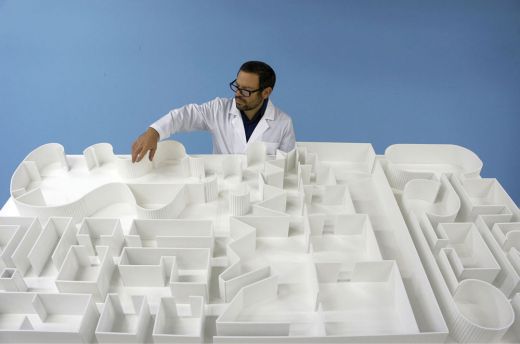
Installation view of Pedro Reyes' Sanatorium at the Whitechapel Gallery in London. Photo courtesy of the artist.
PEDRO REYES: Not all the projects I do have agency. For some, participation is an element, for some, politics. There is no dogma that art should produce change. However, we should not deny the possibility.
RAIL: Have you witnessed change as a consequence of your artwork?
REYES: In“Palas por Pistolas”(2008), more than 1,000 trees were planted [with shovels made from melted-down reclaimed weapons in Mexico]. We continue to plant trees. We incorporated instruments to measure effectiveness in the same way that an NGO would. I always hope for projects to have viability outside art institutions. I am trying to get involved in further campaigns for voluntary donations of weapons. We hold workshops to reclaim weapons from 15 to 25 year olds. We are transforming agents of death to life, from weapons to musical instruments. My hope is that these workshops become a state-sponsored activity, where we don’t think of them any more as art, but as a public program. Sanatorium, which I will present at ICA Miami, has already had 20,000 participants. The impact is more subjective, as it deals with intimate narratives. Everyone who signs up for one of the activities fills out a questionnaire before and after the experience.
RAIL: Why Sanatorium in Miami? It has been at the Guggenheim Museum in New York among other places.
REYES: I am interested in the answers in Miami since it’s so international. Many of the therapies are based in shamanistic traditions, though we strip all the ethnic specificity away. Some are more common in Latin America, where ritual is used as a kind of psychological aid. Some of the therapies are almost a secular version of witchcraft.
RAIL: Roles are used in your pUN project, the experimental conference modeled after the United Nations.
REYES: We had representatives for 160 countries out of 186. The “delegates” were there for two days, impressive because in New York everyone is running and it was cold and far to the Queens Museum. It was a huge success. Now we are preparing a second installment in Los Angeles at the Hammer. My hope is to do this annually. It is a very complicated, ambitious game. We structured it like speed-dating. You speak with people from different countries, then move to the next table. Everyone took the role of representing their country very seriously. For a game to be good, you have to take seriously. It’s a paradox! When we want to talk heavy things like politics, a game helps to access solutions. These subjects would be unbearable if we wanted to discuss them in a serious environment.
RAIL: How does this sense of play relate to your newest project?
REYES: I just had show at Jumex with puppets, Permanent Revolution. It was my first production turning the museum into a theatre. The play intertwined art and politics: Diego Rivera invited Trotsky to Mexico and stay in his home, Frida Kahlo falls in love with Trotsky. There is an assassination plot with a Stalinist supporter, against Trotsky. It had romance, murder, art, politics, economics, intrigue, science fiction. Everything. My hope was to create something that wide audiences could follow. It’s going to tour Mexico; I’d like it to circulate in theaters.
RAIL: Do you think that art is necessarily more powerful outside of museums?
REYES: I think of a museum in two ways: a fridge, and an oven. A fridge keeps things the right temperature for posterity. In an oven, you put in the ingredients and make something new. I often think of the museum as a site of production of alternative realities.
Amanda Sanfilippo is a writer, curator, and art administrator currently working for Locust Projects in Miami. She has worked for the Whitney Museum of American Art and Creative time in New York, and the BCA Center in Burlington, Vermont.










